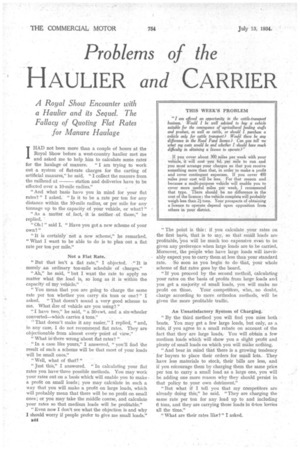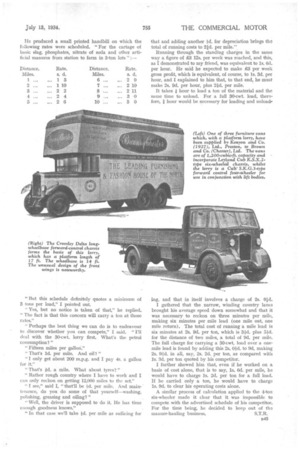Problems of the
Page 58

Page 59

If you've noticed an error in this article please click here to report it so we can fix it.
HAULIER and CARRIER
A Royal Show Encounter with a Haulier and its Sequel. The Fallacy of Quoting Flat Rates for Manure Haulage
IHAD not been more than a couple of hours at the Royal Show before a west-country haulier met me and asked me to help him to calculate some rates for the haulage of manure. "I am frying to work out a system of flat-rate charges for the carting of artificial manures," he said. "I collect the manure from
the railhead at station and deliveries have to be effected over a 10-mile radius."
"And what basis have you in mind for your flat rates? " I asked. "Is it to be a rate per ton for any distance within the 10-mile radius, or per mile for any tonnage up to the capacity of your vehicle, or what?"
"As a matter of fact, it is neither of those," he replied.
"Oh I" said I. "Have you got a new scheme of your own? "
"It is certainly not a new scheme," he remarked. "What I want to be able to do is to plan out a flat rate per ton per mile."
Not a Flat Rate.
" But that isn't a flat rate," I objected. "It is merely an ordinary ton-mile schedule of charges."
" Ah," he said, "but I want the rate to apply no matter what the load is, so long as it is within the capacity of my vehicle," "You mean that you are going to charge the same rate per ton whether you carry six tons or one?" I asked, "That doesn't sound a very good scheme to me. What gize of vehicle are you using?"
" I have two," he said, "a 30-cwt. and a six-wheeler converted—which carries 4 tons."
" That doesn't make it any easier," I replied, "and, in any case, I do not recommend flat rates. They are objectionable from almost every point of view."
"What is there wrong about flat rates?"
"In a case like yours," I answered, " you'll find the result of such a scheme will be that most of your loads will be small ones."
"Well, what of that? "
" Just this," I answered. "In calculating your flat rates you have three possible methods. You may work your rates out on a basis which will enable you to make a profit on small loads; you may calculate in such a ay that you will make a profit on large loads, which will probably mean that there will be no profit on small ones; or you may take the middle course, and calculate your rates so that medium loads will be profitable."
"Even now I don't see what the objection is and why I should worry if people prefer to give me small loads."
B44 'The point is this : if you calculate your rates on the first basis, that is to say, so that small loads are profitable, 'you will be much too expensive even to be given any preference when large loads are to be carried. Moreover, the people who have large loads will inevitably expect you to carry them at less than your standard rate. So soon as you begin to do that, your whole scheme of flat rates goes by the board.
'If you proceed by the second method, calculating your rates on the basis of profits from large loads and you get a majority of small loads, you will make no profit on those. Your competitors, who, no doubt, charge according to more orthodox methods, will be given the more profitable traffic.
An Unsatisfactory System of Charging.
" By the third method you will find you miss both boats. You may get a few large loads, but only, as a rule, if you agree to a small rebate on account of the fact that they are large loads. You will obtain a few medium loads which will show you a slight profit and plenty of small loads on which you will make nothing.
"And bear in mind that there is a growing tendency for buyers to place their orders for small lots. They have less materials to stock, their bills are less, and if you encourage them by charging them the same price per ton to carry a small load as a large one, you will be adding one more reason why they should persist in that policy to your own detriment."
"But what if I tell you that my competitors are already doing this," he said. "They are charging the same rate per ton for any load up to and including 6 tons, and they are carrying these loads in 6-ton lorries all the time."
"What are their rates like?" I asked. He produced a small printed handbill on which the following rates were scheduled. "For the cartage of basic slag, phosphates, nitrate of soda and other artificial manures from station to farm in 3-ton lots " "But this schedule definitely quotes a minimum oE 3 tons per load," I pointed out.
"Yes, but no notice is taken of that," he replied. "The fact is that this concern will carry a ion at those rates."
"Perhaps the best thing we can do is to endeavour to discover whether you can compete," I said. "I'll deal with the 30-cwt. lorry first. What's the petrol consumption?"
"Fifteen miles per gallon."
"That's 1d. per mile. And oil?"
"I only get about 200 m.p.g. and I pay 4s. a gallon for it."
"That's 4d. a mile. What about tyres?"
" Rather rough country where I have to work and I can onlY reckon on getting 12,000 miles to the set" " I see," said I, "that'll be id. per mile. And maintenance, do you do some of that yourself—washing, polishing, greasing and oiling?"
Well, the driver is supposed to do it He has time enough goodness knows."
" In that case we'll take id. per mile as sufficing for that and adding another id. for depreciation brings the total of running costs to 21d. per mile."
Running through the standing charges in the same way a figure of £3 12s. per week was reached, and this, as I demonstrated to my friend, was equivalent to is. 6d. per hour. He said he expected to make a per week gross profit, which is equivalent, of course, to 1s. 3d. per hour, and I explained to him that, to that end, he must make 2s. 9d. per hour, plus 2id. per mile.
It takes i hour to load a ton of the material and the same time to unload. For a full 30-cwt load, therefore, hour would be necessary for loading and unload ing, and that in itself involves a charge of 2s. old.
I gathered that the narrow, winding country lanes brought his average speed down somewhat and that it was necessary to reckon on three minutes per mile, making six minutes per mile lead (one mile out, one mile return). The total cost of running a mile lead is six minutes at 2s. 9d. per ton, which is 31d. plus 5id. for the distance of two miles, a total of 9d. per mile. The full charge for carrying a 30-cwt. load over a onemile lead is found by adding this 2s. Old. to 9d, making 2s. Did. in all, say, 2s. 2d. per ton, as compared with 1s. 3d. per ton quoted by his competitor.
I further showed him that, even if he worked on a basis of cost alone, that is to say, 1s. 6d. per mile, he would have to charge Is. 2d. per ton for a full load. If he carried only a ton, he would have to charge is. 9d. to clear his operating costs alone.
A similar process of calculation applied to the 4-ton six-wheekr made it clear that it was impossible to compete with the advertised schedule of his competitor. For the time being, he decided to keep out of the manure-hauling business. S.T.R.




























































































